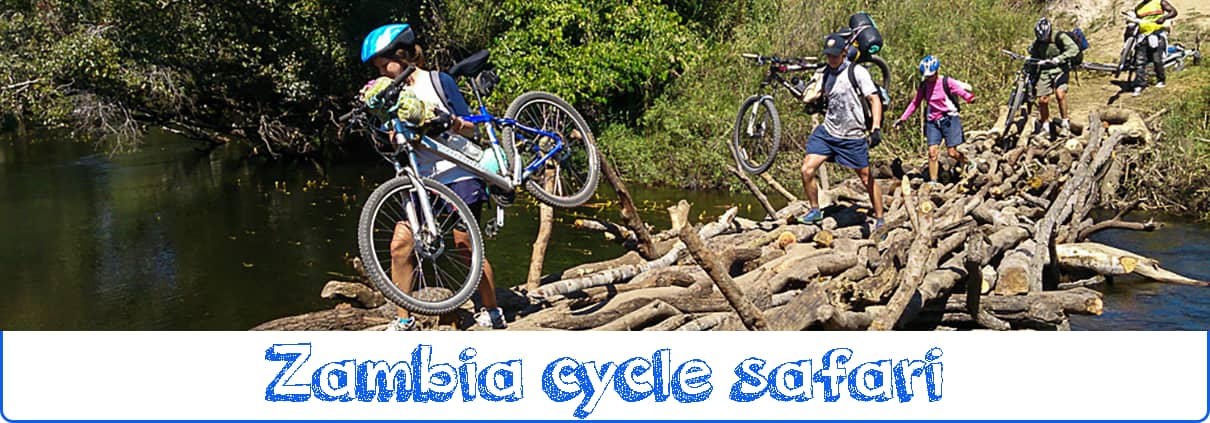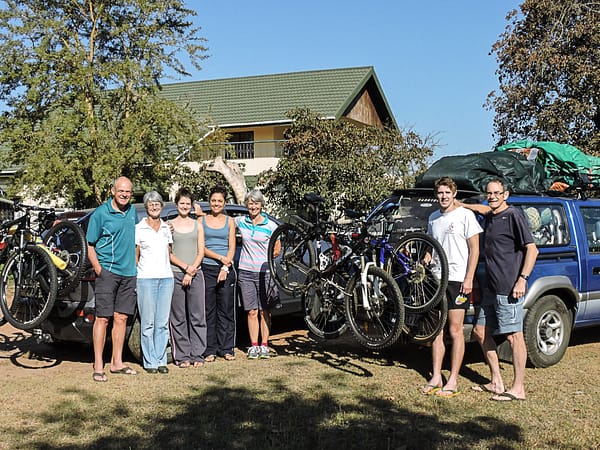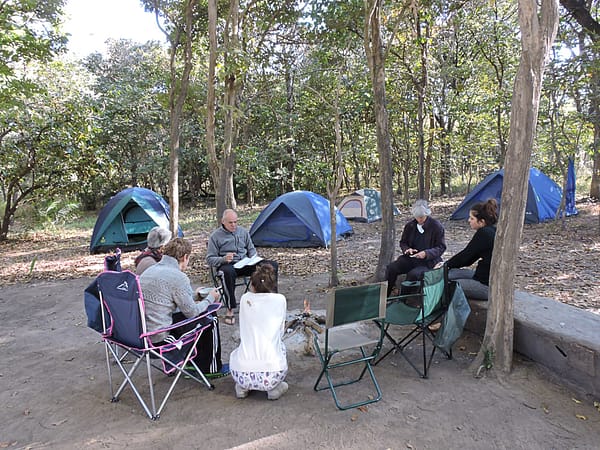Zambia bike safari

Written by Mike Coppinger
One of the privileges of my job is that I get to travel around Africa. Often when I’m soaring through clear skies I gaze down on vast wilderness expanses and imagine traversing those territories by foot.
In July 2015 I had an opportunity to turn those dreams into reality. Better than that, I was able to share the experience with my family. Our primary objective was to explore a remote part of north-eastern Zambia by bicycle, following a route that approximated the reverse of David Livingstone’s final journey.
Safari video by Robert Coppinger
The odometer of my old Isuzu double cab showed that it had recently clicked over the 300 thousand kilometre mark, and I trusted it was up to the challenge of getting us there from South Africa. Packing in 5 people, their baggage, camping and cycling equipment, plus 3 bicycles created a spectacle that put all local transport to shame. The piles of ‘katundu’ on the roof and the bike racks protruding way behind the vehicle attracted plenty of attention from policemen along the way.
That was our section of the party. My elder brother and his wife, Dick and Dickie – yes, that’s correct – looked more respectable in their Nissan Qashqai, with another 2 bikes hanging on their rack.

Dick, Jo, Julie-Ann, Carmen, Dickie, Rob and Mike en route in Lusaka
Five days driving from Durban brought us to Zambia’s Kasanka National Park. We arrived at the campsite in the dark, but dawn welcomed us with the spectacle of rare Sitatunga antelope grazing along the banks of the Kasanka river. We then spent the day planning our cycling route, gathering information about local conditions and preparing our bikes and equipment.

Team briefing at Kasanka
It was a short drive to the Livingstone Memorial, situated at the place where Livingstone died under a Mpundu tree. Dick and Dickie, together with our adult children, Julie-Ann and Robert and a friend, Carmen, saddled up for stage one of the cycling safari. Dick had recruited 2 local guides to lead them on the 45 kilometre ride to Shoebill camp, situated in the Bangweulu swamps. My wife, Jo, and I faced a different challenge in the form of getting the vehicles to the same destination via a very roundabout route. Our circuitous 250 kilometre passage took us largely along unknown and unsigned bush tracks. Night had long fallen by the time we picked out the lights of Chikuni game scout camp flickering on the horizon. Guided by the lights, we bumped across a floodplain until we were halted by a channel that seemed to form a moat around the camp. One of the scouts came to our rescue and led us to a group of cold and hungry cyclists at the nearby Shoebill campsite. Our arrival with food and camping kit worked wonders for our popularity!
Two nights at the rustic Shoebill campsite were punctuated regularly with the sound of thousands of Black Lechwe stampeding through shallow water, after being spooked by prowling hyenas. During the day, other than marvelling at the vast herds of antelope, we searched for the extraordinary bird after which the camp is named. We met with mixed results, as most of the birds had retreated further into the swamps with the onset of the dry season. We did catch a glimpse of one individual that we flushed from a reedbed and followed that up with a close encounter with a semi-tame specimen that was being rehabilitated at Chikuni.
Black Lechwe form the backdrop as we traverse the Bangweulu floodplain
I made it into the team for the next cycling leg, which was an unsupported safari from Shoebill to Shiwa Ngandu, a very isolated British manor house built by Stuart Gore Brown early in the last century. It is an interesting story how the house came to be there and a book has been written about it. Jo and Carmen drew the driving straws on this occasion. Dick, Dickie, Julie-Ann, Rob and I waved them goodbye and then wobbled off on our bikes, loaded with camping kit and supplies for the next 3 days.
Single track through the miombo
For the first two days our guides, first Raphael and later Mutale, led us on smooth, single track trails that cut across wide grassy plains, skirted forest patches and wound through beautiful miombo woodland. When we passed through villages we were accorded celebrity status and our river crossings invariably attracted an excited audience. We revelled in the unique situations and experience, which met and exceeded everything we had hoped for.
The ladies got some help during one river crossing at least
Crossing the Lumbatwa river
When we made camp on the second night we realised that we had covered 100km but had a further 120km to cover on the final day. Hitting the trail at daybreak, we found the going tough from the outset. Having hitherto been absolutely flat, Zambia now seemed to be at a perpetual incline, the sun burned down and for the most part we were travelling on jeep tracks, rather than the more appealing single track.
Day three takes its toll
When nightfall found us well short of our destination, not only our energy was exhausted, but also our water and virtually all of our food. With full moon having passed two nights previously, the twilight faded into blackness. Faced with the prospect of a thirsty and hungry night in the tent, we decided to rather press on. With one head torch between us that was capable of revealing the track ahead, we clustered like a group of insects around the beam and worked our way cautiously through the darkness. After a couple of hours of painstaking progress, the torchlight picked out a sign that read ‘Kapishya Hot Springs’ – the words we had been searching for!
A joyful reunion with our support team was celebrated with a long drink of water, followed by another drink of water, some ‘potjiekos’ and then a most welcome night’s rest. Exhaustion and dehydration, and in my case some infected sores, took their toll the next day. Nonetheless, after a day’s recuperation, which included a visit to nearby Shiwa Ngandu, we had to press on to our next rendezvous. This was with our other brother, John, at the top of the Muchinga escarpment, for the final cycling stage, following the track down the escarpment and across the valley floor to the Luangwa river. The Luangwa’s status as one of Africa’s outstanding wildlife areas added a different spice to our safari. Within hours of setting off, the cycling party encountered a pack of wild dogs, as we traversed the corridor between the North and South Luangwa National Parks.
Into the Luangwa!
After three days of pedalling, we crossed the river and settled in at Kalovia campsite. There we enjoyed three nights in one place – what a treat! Fresh supplies from John’s nearby Tafika lodge, spectacular game viewing and simple relaxation – we were now getting close to what most people would call a holiday!
The final act of the safari was the 4 day drive home, via Mozambique. By the time we pulled into our garage, the Isuzu had clocked up another 7,700km. Our 3 weeks of travel across 5 countries had included a hefty dose of border officials and police checks, plus many logistical challenges. That was a small price to pay for the extraordinary experiences and priceless family memories that we forged.
Next time I gaze from on high upon a sea of African woodland, my longing to be ‘down there and in it’ will be just as great, but will be accompanied by a gratitude for having had such a special opportunity to live the African experience.














